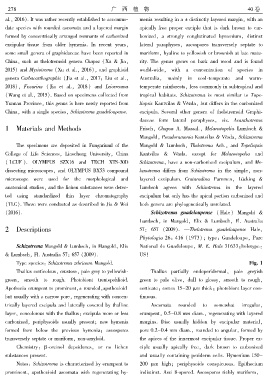Page 141 - 《广西植物》2020年第2期
P. 141
2 7 8 广 西 植 物 40 卷
al.ꎬ 2016). It was rather recently established to accommo ̄ menia resulting in a ± distinctly layered marginꎬ with an
date species with rounded ascomata and a layered margin apically free proper exciple that is dark brown to car ̄
formed by concentrically arranged remnants of carbonized bonizedꎬ a strongly conglutinated hymeniumꎬ distinct
excipular tissue from older hymenia. In recent yearsꎬ lateral paraphysesꎬ ascospores transversely septate to
some small genera of graphidaceae have been reported in muriformꎬ hyaline to yellowish or brownish at late matu ̄
Chinaꎬ such as thelotremoid genera Chapsa (Xu & Jiaꎬ rity. The genus grows on bark and wood and is found
2015) and Myriotrema (Xu et al.ꎬ 2016)ꎬ and graphioid world ̄wideꎬ with a concentration of species in
genera Carbacarthographis (Jia et al.ꎬ 2017ꎻ Liu et al.ꎬ Australiaꎬ mainly in cool ̄temperate and warm ̄
2018)ꎬ Fissurina ( Jia et al.ꎬ 2018) and Leiorreuma temperate rainforestsꎬ less commonly in subtropical and
(Wang et al.ꎬ 2015). Based on specimens collected from tropical habitats. Schizotrema is most similar to Tope ̄
Yunnan Provinceꎬ this genus is here newly reported from liopsis Kantvilas & Vězdaꎬ but differs in the carbonized
Chinaꎬ with a single speciesꎬ Schizotrema guadeloupense. excipula. Several other genera of thelotremoid Graphi ̄
daceae form lateral paraphysesꎬ viz. Acanthotrema
1 Materials and Methods Frischꎬ Chapsa A. Massal.ꎬ Melanotopelia Lumbsch &
Mangoldꎬ Pseudoramonia Kantvilas & Vězdaꎬ Schizotrema
The specimens are deposited in Fungariuml of the Mangold & Lumbschꎬ Thelotrema Ach.ꎬ and Topeliopsis
College of Life Sciencesꎬ Liaocheng Universityꎬ China Kantvilas & Vězda. except for Melanotopelia and
( LCUF ). OLYMPUS SZX16 and TECH XTS ̄30D Schizotremaꎬ have a non ̄carbonized excipulumꎬ and Me ̄
dissecting microscopesꎬ and OLYMPUS BX53 compound lanotrema differs from Schizotrema in the simpleꎬ non ̄
microscope were used for the morphological and layered excipulum. Crutarndina Parnmenꎬ Lücking &
anatomical studiesꎬ and the lichen substances were detec ̄ Lumbsch agrees with Schizotrema in the layered
ted using standardized thin layer chromatography excipulum but only has the apical portion carbonized and
(TLC). These were conducted as described in Jia & Wei both genera are phylogenetically unrelated.
(2016). Schizotrema guadeloupense ( Hale ) Mangold &
Lumbschꎬ in Mangoldꎬ Elix & Lumbschꎬ Fl. Australia
2 Descriptions 57: 657 (2009). —Thelotrema guadeloupense Haleꎬ
Phytologia 26: 416 (1973)ꎻ type: Guadeloupeꎬ Parc
Schizotrema Mangold & Lumbschꎬ in Mangoldꎬ Elix National de Guadeloupeꎬ M. E. Hale 31633ꎻholotype:
& Lumbschꎬ Fl. Australia 57: 657 (2009). US!
Type species: Schizotrema zebrinum Mangold. Fig. 1
Thallus corticolousꎬ crustoseꎬ pale grey to yellowish ̄ Thallus partially endoperidermalꎬ pale greyish
greenꎬ smooth to rough. Photobiont trentepohlioid. green to pale oliveꎬ dull to glossyꎬ smooth to roughꎬ
Apothecia erumpent to prominentꎬ± roundedꎬapothecioid corticateꎻ cortex 15-20 μm thickꎻ photobiont layer con ̄
but usually with a narrow poreꎬ regenerating with concen ̄ tinuous.
trically layered excipula and laterally covered by thalline Ascomata rounded to somewhat irregularꎬ
layerꎬ concolorous with the thallusꎻ excipula more or less erumpentꎬ 0.5-0.8 mm diam.ꎬ regenerating with layered
carbonizedꎬ periphysoids usually presentꎻ new hymenia margins. Disc usually hidden by excipular materialꎬ
formed from below the previous hymeniaꎻ ascospores pore 0.2-0.4 mm diam.ꎬ rounded to angularꎬ formed by
transversely septate or muriformꎬ non ̄amyloid. the apices of the innermost excipular tissue. Proper ex ̄
Chemistry: β ̄orcinol depsidonesꎬ or no lichen ciple usually apically freeꎬ dark brown to carbonized
substances present. and usually containing periderm cells. Hymenium 150-
Notes: Schizotrema is characterized by erumpent to 200 μm highꎻ periphysoids conspicuous. Epithecium
prominentꎬ apothecioid ascomata with regenerating hy ̄ indistinct. Asci 8 ̄spored. Ascospores richly muriformꎬ

